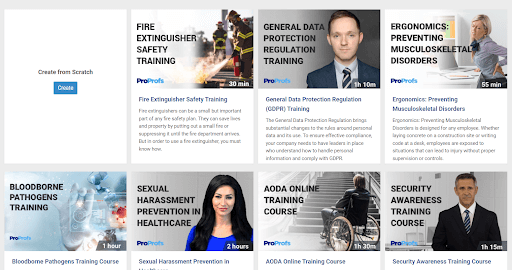HR managers face innumerable challenges, one of which is keeping the employees engaged throughout the onboarding process.
This is why knowing the 5Cs of onboarding is essential.
So, what can you do to keep the new employees engaged?
The answer is simple.
Put the 5Cs into action and make it an integral part of your recruitment process.
Before doing this, you need to understand the meaning and importance of employee onboarding. And then, you’ll discover how these 5Cs are effective for new hire onboarding to ensure better engagement, check turnover, and boost productivity in the long run.
What Is Employee Onboarding?
Employee onboarding is a process of introducing new employees to the company’s work culture and their responsibilities in the organization.
It includes a set of procedures/steps to make the employee familiar with the tools and resources essential to make them productive from day one.
A well-structured onboarding process ensures:
- More than 82% of employee retention
- The median revenue of $169,100 per employee
- 69% of employees stay with an organization for three years
The latest onboarding statistics reveal that a poor employee onboarding policy reduces productivity and employee turnover drastically. As per reports,
- 23% of employees say they left the company within six months due to a lack of training and guidelines on the roles and responsibilities.
- 51% of employees say – they’ll go above and beyond if they receive a good onboarding.
- Only 21% of employees agreed that their organization has a good onboarding process.
Now, the question is, what are the best practices for onboarding new employees? And how to ensure your new hires stay engaged throughout the process?
WATCH: How to Create an Employee Onboarding Training Program
There are many factors at play here, and you also need to consider the aspect that remote working has become the new norm after the pandemic.
Keeping that in mind, you need to think of a strategy that would aid in successful onboarding.
By using employee onboarding software and incorporating the 5Cs of onboarding, an organization can enhance employee retention and save time and money.

Let’s now understand why it’s important to have a good onboarding process.
Importance of Employee Onboarding
Onboarding is important because it:
- Reduces employee turnover and boosts productivity
- Ensures employee compliance from the first day
- Makes it easy for employees to embrace the new work culture
- Encourages new hires
According to the reports from CareerBuilder & SilkRoad (2019), 93% of employees agreed that a good onboarding experience determines if a new employee will continue working with that organization.
In this context, let’s explain the importance of employee onboarding.
Reduces Employee Turnover and Boosts Productivity
Employee turnovers prove costly for organizations! But how much? These statistics provide the answer:
✓ The U.S. industries had to pay more than $630 billion as a turnover cost.
✓ SHRM estimates that it costs 100-300% of the individual’s salary to replace an employee.
When an employee leaves, the other workers have to pick up the slack, leading to the wastage of the organization’s time and resources.
That’s why a powerful onboarding process is important.
Onboarding programs pay off in the long run, and the best employee onboarding software can automate the training process.
Ensures Employee Compliance from the Very First Day
A business needs a compliance program to build a knowledgeable workforce, ensure compliance with industry rules and regulations, and avoid legal liabilities. Onboarding is the first step to maintaining compliance.
In fact, the first C of 5Cs of onboarding talks about compliance.
Through compliance training, your employees learn about proper conduct and behavior expected from them. This includes training on sexual harassment, drug-free workplace training, etc.
Watch: Federal Sexual Harassment Training Course
Enhances Employee Engagement
Once an employee gets acquainted with the company policies, cultural values, and work ethics, they’re more likely to stay engaged.
An engaged employee delivers better productivity – in other words, they stay committed to the organization and their responsibilities.
A good employee onboarding policy offers an ideal opportunity to foster a supportive bonding between the newcomers and the management. Most importantly, it enhances employee engagement.
The 5Cs of Employee Onboarding
The 5Cs of onboarding are standards to improve the onboarding process. They stand for:
- Compliance
- Clarification
- Culture
- Connection
- Checkback
One of the best tips for onboarding new employees is to add the 5Cs into your onboarding process to set your recruits up for success.
A Brief History of 5Cs
The onboarding process in the old times included lots of paperwork and creating and distributing employee handbooks.
But the current process has completely changed.
Organizations in recent times prefer a well-designed process for onboarding new hires.
And you’ll be surprised to know that onboarding has become one of the white-hot HR processes.
Initially, most organizations incorporated the 4Cs of onboarding (Compliance, Clarification, Culture, and Connection) into their onboarding programs based on the processes laid down by the Society for Human Resource Management (SHRM).
Dr. Tayla Bauer from the SHRM Foundation says that a successful onboarding process proactively covers the four Cs of onboarding.
The fifth ‘C,’ i.e., Checkback, was added much later as an essential component of employee onboarding to add a layer of practicality and receive feedback from the new hires.
That’s how organizations adopted the 5Cs, giving way to better job attitudes, faster adjustments, higher employee retention, higher productivity, and better employee engagement.
Watch: How to Create an Employee Handbook
All About the 5Cs
Organizations should consider the 5Cs as a part of their onboarding strategy. The 5Cs stand for:
1. Compliance
It refers to the company policies and procedures that every new employee should know. It consists of mandatory tasks that employees have to abide by.
It is a crucial onboarding checklist.
It involves a formal orientation with the HR that includes paperwork, departmental procedures, safety regulations, and confidentiality requirements.
To maintain compliance, you can introduce your employees to the company’s policies and make them sign confidential documents like Terms of Agreements, NDA, etc.

Compliance should also include training your employees on how to report incidents of harassment or manage consumer complaints.
2. Clarification
HRs should clarify the roles and responsibilities of the employee. This also includes clarifying the performance expectations, salary hike, and how to perform their specific roles.
A new employee can have lots of questions when joining a new organization.
- What is their role in the organization?
- Who all are the team members?
- Who is the reporting manager?
- How does the organization work?
- What goals are to be accomplished by the employee as a team member and as an individual contributor?
A good onboarding process answers all the organization-related queries that an employee may have.
3. Culture
It refers to the company’s beliefs, norms, standards, values, symbols, and stories.
Train your employees on cultural values. It’s a great way to let your employees know what matters the most within your organization.
You can take a few steps to give the best impression about your company.
- Inform them: Create an employee handbook to guide and inform the new employees about the company’s history and policies like anti-harassment laws, safety measures, and more.
- Make them feel involved: Make your new employees a part of the upcoming cultural events to promote the feeling of equity and inclusion.
- Train them: This is also the right time to train them on the concepts of diversity, equity and inclusion so that they have complete awareness of working in an open and safe space.
Watch: What Is Diversity, Equity & Inclusion? | Training Course Introduction
Besides these existing programs, share the goals for the upcoming year and let them contribute from day one.
4. Connection
It helps the new joiners foster a good relationship with their reporting managers and team members in the new workspace.
Reports and research have consistently shown that a sense of belonging can enhance productivity and organizational success.
When new joiners feel connected, they also become confident, collaborate with their peers, and come up with innovative ideas.
Out of all the 5Cs of onboarding, connection plays a fundamental role. It’s a factor that makes the new hires feel they’ve joined the right organization.
You can take several measures to forge powerful connections right from day one. For example, a welcome email, gifts, or video can go a long way in making your employees feel connected to their workplace.

5. Checkback
Checkbacks are important for long-term organizational success. As the name suggests, it refers to employees’ feedback on the onboarding process.
Sometimes, even the most welcoming onboarding programs fail to deliver the expected results. That’s why checkbacks are so important.
The only way to get a response about the process is to ask the new employees.
You may use onboarding tools or create online surveys to get real-time feedback from the new hires.

Checkbacks let you adjust your online program and trace the problem areas.
Do not forget to survey the managers and other stakeholders on the onboarding process. This helps in knowing what is working well and what is not.
Identifying the loopholes makes it easy to incorporate the necessary changes and ensures a world-class onboarding experience for your new hires.
Each of the C’s is important to make the newcomers feel comfortable and welcomed. For a successful onboarding program and to ensure better productivity of your employees, you need to master the 5Cs.
Watch: Hiring & Interviewing Training
To create your onboarding strategy, you can take references from the 10 best employee onboarding examples.
Along with this, you’ll need to learn how to get the best tool to do the job. Dive into the next section to know that.
Get Free Employee Training Software — All Features, Forever.
We've helped 567 companies train 200,000+ employees. Create courses in under a minute with our AI LMS or use 200+ ready-made courses on compliance, harassment, DEI, onboarding, and more!
How to Choose the Best Software for Employee Onboarding
Now that you’ve understood the importance of onboarding and the 5Cs approach, it’s time to find the best onboarding software to train your recruits on the company’s vision, culture, products, and services.
Let’s take a look at the things you should keep in mind for choosing the right software for employee onboarding.
Course Creation Ability
Look for an LMS that lets you create courses to make your training sessions more interactive and engaging.
You can add images, videos, PDFs, games, for this and even embed quizzes to test your participants.
It would be amazing if it has built-in courses for instant use with customization features.
Watch: How to Create an Online Course
Supports Mobile Learning
Choose an LMS that supports mobile learning. It should allow easy access to courses, assign microlearning modules, view individual progress, and check the test results from a smartphone.
Ready-to-Use Templates
Pick a software that provides a new employee onboarding template for instant use. This will save your time and effort.
Moreover, the software should let you customize the dummy content. You should be able to add your content, images, videos, and company logo.

Supports Training with Surveys, Quizzes, and Tests
Evaluating the employees’ progress, performance, and feedback is essential. All these are important, particularly for three reasons:
- To know if the program is going in the right direction
- For knowledge retention
- To understand which areas of the training require improvement
Tests, quizzes, and surveys are great for tracking employee performance and receiving feedback.

24/7 Support
Every software is unique, and you’ll need assistance from the respective support team during setup and integration. Choose an LMS vendor who’ll be able to provide end-to-end assistance when the need arises.
Make the Most of Your Employee Onboarding Program
Incorporating the 5Cs of onboarding into your onboarding program is key to reducing employee turnover, boosting engagement, and enhancing productivity. It takes care of all the vital aspects of a standard onboarding program.
Every C of the 5Cs is essential to welcome new employees and make them comfortable with the new work culture.
Apart from implementing the 5Cs, HRs need to have powerful employee training software to ensure an engaging onboarding experience and put new hires in a productive mode from the very first day.
Furthermore, an online training tool will also simplify the training process for remote workers.


 We'd love your feedback!
We'd love your feedback! Thanks for your feedback!
Thanks for your feedback!








